Restaurant Prime Cost Calculation
What is the restaurant prime cost calculation? What numbers go into the prime cost calculation? Watch this video for an easy breakdown this number, which I call the most important number in your restaurant.
The one number all restaurants must know to be profitable is their prime cost. The prime cost calculation is made up the total cost of goods sold and labor cost.
So what is the prime cost equation? The prime cost calculation? It’s very simple. It’s total cost of goods sold plus total labor cost (including raw labor, taxes, benefits and insurance). Take that number and divide it by gross sales before discounts are taken out, not including sales tax.
That is the formula for restaurants.
So, you calculate your prime cost. Then what? Well, if your total prime cost is higher than 55% and you make $850,000/year or more in sales, then you have room to trim, which is room for more profits.
How do you get to those additional profits? With systems that control your prime cost.
1. Budgets
2. Recipe costing cards
3. Purchasing systems
4. Scheduling systems
It’s one thing to know what your prime cost it – it’s another to learn how to control it.
NOTE: True cost of goods sold can only be calculated when you take inventories to find the value of every product you have on your shelves at least once a month, preferably once a week. This is required because to know your cost of goods sold, you take your beginning inventory and add all of your purchases (even if they were not paid for) to get your total available to sell. Then subtract your ending inventory to find out what product was used in that period, or in other words, left the shelves between those two inventories, whether it was sold, wasted, spoiled or stolen. Product used divided by gross sales gives you your cost of goods sold percentage. Gross sales is defined as the ring at the register before discounts are taken out and not including sales tax (sales tax collected is not a sale).
If you don’t take inventories for value, the way you find our cost of goods sold percentage is to take the past 12 months of purchases and divide them by sales for the same 12 months. While this is not a perfect number, it’s pretty darn close because the difference in starting and ending inventories will not really change that number much.
You can also keep this article on hand for easy reference when it comes to the prime cost calculation.
To learn more about the restaurant prime cost calculation and how to reach it in your restaurant, read our special report, Breaking Away from the Insanity: How to easily take control of your restaurant and make more money. Download it here.





